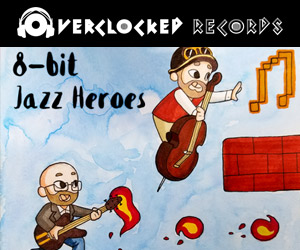ReMix:The Legend of Zelda: Ocarina of Time "Temple of Time: Chant & Carillon" 8:38
By Woody/mC
Arranging the music of one song...
"Temple of Time"
Primary Game: The Legend of Zelda: Ocarina of Time (Nintendo , 1998, N64), music by Koji KondoPosted 2022-06-09, evaluated by the judges panel
Very cool & distinct solo pipe organ Zelda arrangement from newcomer Woody/mC that rewards listener patience with a blossoming, grand, entirely-improvised 8+ minute interpretation & meditation:
"It's been over a decade now since my first (unsuccessful) submission, so I thought it could be worth a retry with one of my more recent live improvisations, which might be a bit... uhmmm... unconventional. Meanwhile, I've dug deep into the world of pipe organs as an autodidact, with many lessons learned already and even more to still learn -- but decide for yourself as you take a listen. Hope you'll enjoy!
Following my childhood dream and fascination for pipe organs, to become a self-taught pipe organist with a focus on VGM and movie soundtracks, was an inevitable destiny with regards to my hobby and passion. Thus, the live improvisation on one of TLoZ: OoT's most notable themes is somewhat a milestone for me, as I was able to put that big cathedral grandeur and acoustics into a piece that would be more than fitting as an OST for the place where the game actually placed the original.
The "chant" and "carillon" context doesn't exactly refer to vocals or a bell tower 1:1, but a mere imitation. In fact, "Temple of Time: Chant & Carillon" consists of two interwoven movements, namely the chant portion in the first half (resembling an "accompaniment" to the vocals heard in the OST) and the carillon section, which refers to a "carillon piece" in the context of pipe organ music; these try to imitate the ringing of church bells through fast arpeggiated chords while the main melody is often played with the left hand on another manual or with even the feet using the pedals, featuring a different registration (= timbre).
Regarding the slow start: This is a common issue in my live impro sessions (let's call it "the motif gathering phase") where ideas keep pouring in to my brain and fingers and need a bit of time to consolidate into some sort of "stable equilibrium." According to my observation, there's another issue on the listener's side with this kind of music; impatience is a very wide-spread character trait today, which makes it hard to "narrate a full paragraph" in a musical context.
REAL epicness starts at 5:19.
Self-check/trivia: If you manage to listen to this for more than 2m53s (or 32.8%), you're more patient than the average listener.The piece itself features almost the full dynamic range of the organ with a more or less linear increase, reaching its first culmination point at a striking dissonant chord around 6:10, before it enters the finale section which eventually utilises "full organ" (= all stops activated) for the final chords cadence (hope you'll own a decent LFE to enjoy the frequencies around ~16Hz). My favorite part starts at 6:10, when the big fat dissonant chord hits. Can't remember exactly, but I think I had all of my fingers on at least one key per finger. ^^
Just like many of my other creations, this has been played live at home using a three-manual DIY organ console with Milan Digital Audio's Hauptwerk as the software backbone and features MDA's 1903 Notre Dame de Metz sample set being mapped to four different speaker pairs. The "audio artifacts" you might notice, such as key attacks, blower noise, and some hizz from certain pipe ranks, are indeed intended to be present in the final recording and are both a sign of realism and paying attention to the details when the sample set was recorded as well as they're vital for the authenticity of the piece's final recording.
It should be noted that this exact recording -- like pretty much all of my music -- is a unique on-the-fly improvisation, which means that it cannot be revised or otherwise be "polished" in any way, not even for a resubmission attempt. There is no sheet music available. Be sure to watch the VOD if you'd like to see the pictures that I had in mind when I improvised this (and for some nice goosebumps during the final measures -- at least I hope so).
I'm still confident that Mr. Koji Kondo would find this one day (without that Nintendo lawsuit stuff, please ^^)... Meanwhile, spreading the word on social media would be highly appreciated to let that dream come true! :)"
Well, unlike some other Japanese VGM composers who have embraced social media, Kondo is a bit more elusive... but I have to think he'd dig this very different, evolving arrangement of his OoT work. It starts simple enough, but as things progress, the harmonic complexity & overall volume definitely ramp up. It's impressive that this was improvised; there are simpler bits, like the intro the artist alludes to, but it never feels like it's spinning its wheels. There's a meditative & spiritual quality to the overall piece, transitions feel natural, and the ambience & artifacts avoid a too-pristine quality and give the instrument a believable space in which to shine. Judges were unanimous; prophetik music is one of our stronger music theory ninjas, and his breakdown/analysis was super-helpful:
- "0:00 - 0:15 - A
- 0:15 - 0:37 - A with expansion
- 0:37 - 0:47 - reminiscent of the start of the C section but i didn't see a direct parallel
- 0:47-0:57 - middle of A with expansion
- 0:57-1:13 - this sounds like it's following the shape of C but no direct parallel
- 1:13-1:35 - A with expansion again
- 1:36-2:07 - descending line is the end of A pretty consistently (3-4-5-1 pattern), but this is a tenuous connection, if i'm stopwatching i count half of this time in total
- 2:07-2:26 - this continues using rhythmic motifs from the original but i don't hear a lot of melodic connection
- 2:26-2:47 - more expansion of A
- 2:48-3:10 - pad chord with C melodic portions
- 3:10-3:52 - cadential pattern leading to descending fifth motif from most of the original, with A-reminiscent expansion in the foot pedals (i love this section)
- 3:52-4:21 - recap of A and a beautiful resolution
- 4:21-4:53 - traditional carillon intro, with flourish over root movement, expansion of the tail of A
- 4:53-5:19 - continuing root movement, registration change but no clear melodic content
- 5:19-5:44 - A section recap, clear melodic content, with condensed B motif following
- 5:44-6:20 - more escalation content, sounds like the implied chords from B
- 6:20-6:59 - more A under right hand flourish
- 6:59-7:35 - B content, malformed, following a straightforward A recap and some more escalation content
- 7:35-8:30 - registration change, same escalation content, final chord and tail
this is well over the 50% mark for at least motivic representation. that's my only concern, because the rest of the work is superb. there's a clear two-movement concept being relayed here, and the registration choices and improvisation throughout are excellent. if anything, i wish there was more motivic development - there was a ton of room to explore other tonalities and get even crunchier from a compositional standpoint. i also didn't hear as much B content and would have liked that, but that's such a nitpick it's hardly anything.
this is a clear pass for me. the intense care taken on the realism aspect, the expansive arrangement, superb registration work, and perfect soundscape all really make this a mix i can't wait to see on the site."
Ditto; beyond all of the above, most of the solo arrangements we get are piano, and second most popular is probably acoustic guitar, so it's nice to see some variety in this arena. While the minimalist, exploratory intro reflects the "solo" aspect, by the time the mix is over, the artist has reached the grand, epic heights that a full pipe organ can achieve, and you'll forget it's a solo performance. Hauptwerk is one of the few pieces of music software I've never touched, but it sounds absolutely sublime; color me impressed. DarkSim adds:
"...Over 8 and a half minutes is a long time for improvisation, and I only counted one instance around 5:25 where it sounds like a duff note has been played. The dissonance around 6:10, as mentioned in the submission email, was intentional. It does a pretty good job of grabbing your attention right before the really fast arpeggiated section.
In Ocarina of Time, Ganondorf can be found playing the organ just before the final battle. The first half of this piece evokes the calm serenity and contemplation offered by the Temple of Time. The second half escalates into - in my mind - the dramatic boss fight at the end of the game. A fitting tribute to the game's lore which I'm sure OoT purists and any pipe organ fans out there will enjoy."
It took over a decade, but I'm glad Woody/mC submitted more work; this is an absolutely singular take on these themes, from someone who clearly respects & wants to leverage the weapon-of-choice, pipe organ, in ways that make both it & the source material shine. Set aside some quality time to sit down, close your eyes, focus, and experience all 8'37" of this memorable debut!
Discussion

on 2024-03-30 18:54:02
1 hour ago, CJthemusicdude said:For the first few minutes, I was just vibing along with the track, having a chill time. Then things kicked up a notch and the organ started going ham and got very interesting! Great piece! :)
Thanks, CJ! "Going ham" is indeed what's going on there, haha. I still can't get enough of that particular dissonant chord, for which IIRC I used my nose to hit an extra key... :)

on 2024-03-30 16:58:47
For the first few minutes, I was just vibing along with the track, having a chill time. Then things kicked up a notch and the organ started going ham and got very interesting! Great piece! :)

on 2022-06-16 16:15:49
4 hours ago, Crono3of3time said:It is a very entertaining song, the entire piece kept me interested through its entirety.
The only issue I had was the "reversing tire" (6:20) with the rolling arpeggio(?) at the end. Just as if you watch a car tire spinning, when it reaches a certain speed, it seems to roll backwards even though it's still keeping pace and nothing is wrong with it. The tire effect seemed to fight with portions of the music as it lost itself in swirling intensity. It may have needed some kind of punctuation anchor to help it feel like it was going forward with the rest of the song. Some artists I've heard overcome it by changing the pitch on each repetition slightly so the casual user can hear each initiation better.
Ah yes, the final carillon part... ![]()
"Reversing tire" is indeed a very fitting analogy. The effect was
intended BTW to draw the listener "away" from it, i.e. to put
more focus on the main melody / cantus firmus in the bass line,
which alternates between the Great and the pedals. But yes,
this can drive people crazy... ![]()

on 2022-06-16 11:19:46
It is a very entertaining song, the entire piece kept me interested through its entirety.
The only issue I had was the "reversing tire" (6:20) with the rolling arpeggio(?) at the end. Just as if you watch a car tire spinning, when it reaches a certain speed, it seems to roll backwards even though it's still keeping pace and nothing is wrong with it. The tire effect seemed to fight with portions of the music as it lost itself in swirling intensity. It may have needed some kind of punctuation anchor to help it feel like it was going forward with the rest of the song. Some artists I've heard overcome it by changing the pitch on each repetition slightly so the casual user can hear each initiation better.
on 2022-06-15 23:56:57
Congradurations Woody mC!! Fantastic ambient organ work as
usual. Wow the second half really Hammers it up...some
serious Bachian goodness there!! ![]()

on 2022-06-15 21:59:46
Congrats Woody! Been following you on YT for awhile…really enjoy what the organ brings to these classics! ?

on 2022-06-13 18:00:37
Such an honor to see this judged and posted !
My sincere gratitude goes to all the judges, motivating listeners and people behind the scenes for their hard work and detailed assessment.

on 2022-06-13 12:41:18
I love how it starts out like regular church music and then gets spookier as it goes along. I think 8 minutes may have been a little excessive but it's memorable!
Sources Arranged (1 Song)
- Primary Game:
-
The Legend of Zelda: Ocarina of Time (Nintendo
, 1998,
N64)
Music by Koji Kondo
- Songs:
- "Temple of Time"
Tags (8)
- Genre:
- Classical
- Mood:
- Epic,Solemn
- Instrumentation:
- Organ
- Additional:
- Arrangement > Minimalist
Arrangement > Solo
Time > Duration: Long
Usage > Wedding
File Information
- Name:
- Legend_of_Zelda_Ocarina_of_Time_Temple_of_Time_Chant_&_Carillon_OC_ReMix.mp3
- Size:
- 13,844,450 bytes
- MD5:
- 193351760717abdbd16dd8cf15208e9c
- Bitrate:
- 212Kbps
- Duration:
- 8:38
Download
- Size: 13,844,450 bytes
- MD5 Checksum: 193351760717abdbd16dd8cf15208e9c
Right-click one of the mirror links above and select "Save Link As" or "Save Target As"!!
Help us save bandwidth - using our torrents saves us bandwidth and lets you download multiple mixes as a single download. Use the tracker below and scroll for more information, or visit https://bt.ocremix.org directly, and please don't forget to help us seed!!
ocremix.org is dedicated to the appreciation and promotion of video game music as an art form. more...
Please support us on Patreon if you can!
Content Policy
(Submission Agreement and Terms of Use)
Page generated Fri, 19 Apr 2024 09:56:37 +0000 in 0.0379 seconds
All compositions, arrangements, images, and trademarks are copyright their
respective owners. Original content is copyright OverClocked ReMix, LLC. For information on RSS and
JavaScript news feeds, linking to us, etc. please refer to resources for webmasters. Please refer to the Info section of the site
and the FAQ available there for information about the
site's history, features, and policies. Contact David W.
Lloyd (djpretzel), webmaster, with feedback or questions not answered there.














